Standardized Protocol
-
- GPS Plots The Future Of Navigation & Communications Maritime Reporter, Mar 1992 #57
The face of maritime navigation and communications will change forever in 1993, when the last of 24 satellites is deployed in the Global Positioning System, making the system fully operational. The Global Positioning System, or GPS, aU.S. military navigation system, will provide allweather, 24-hour coverage worldwide.
GPS signals can also be accessed by civil users but without differential corrections, their accuracy is only about 100 meters. Corrections allow GPS navigation accuracy to be typically improved to under five meters.
Last year, Inmarsat finalized two new data collection and distribution standards to be used for very accurate navigation information for its users, in addition to having potential uses for constantly updated worldwide data and news transmissions.
The standards, one for point-tomultipoint data distribution service and the other a multipoint-to-point "backhaul" facility, have been developed primarily for disseminating differential corrections for GPS navigation signals to Inmarsat-A terminal users.
Typically, a differential correction service provider establishes regional reference sites at which GPS signals are received and positional errors used to generate differential corrections. Using the point-tomultipoint service, these differential corrections are then distributed to mobile users anywhere in the world on the Inmarsat-A system.
"This service will be different from existing point-to-multipoint services on Inmarsat," said George Kinal, manager for navigation and applications at Inmarsat's Land Mobile and Special Services Division, "since it will be available 24 hours-a-day and navigation information will be updated every few seconds for the mobile user." In order to tune in to a land earth station (LES) and receive encoded differential data, Inmarsat-A users need to make arrangements with a service provider and equip themselves with a type-approved add-on device. A simple algorithm will then enable them to apply this to correct GPS signals and derive precise position information.
The Inmarsat-A system permits global two-way telephone, facsimile, telex, E-mail and data communications.
Users will be able to employ their terminals for other telephone and data communications, even while receiving this point-tomultipoint service. For those who are not Inmarsat-A users and who require the navigation facility, modified receive-only terminals will be available.
Point-to-multipoint services have been provided since June 1990 by B r i t i s h Telecom through its Goonhilly LES and by Comsat through its Southbury LES using slightly different transmission standards.
The standardized protocol for transmission t h a t was approved by Inmarsat has enabled such services to be extended worldwide through many other service providers, who will have the option to offer the service at 600, 1,200 or 2,400 bits per second.
Unprocessed GPS signals are collected from reference sites or stations, usually within a few hundred kilometers of the mobile user. The reference stations may j u s t be simplified, unmanned Inmarsat-A terminals connected to GPS receivers.
These terminals may be fixed or semi-permanent depending on the application.
The signals collected at one or more reference points may be fed through terrestrial links to a central processing center where differential correction factors are calculated.
The processing center may be co-located with the LES, or may be at a distance from the LES, in which case, the differential data may then be relayed to the LES through a terrestrial link.
From the LES, the corrections are beamed up to an Inmarsat satellite and then to the users. The entire cycle is repeated frequently (generally under the five seconds) to keep the mobile user constantly updated with accurate navigation and position information.
The accuracy of the corrected navigation signals depends on how far away the user is from the nearest reference station. The interim operations have shown that differential corrections applied from even 300-400 kms away have provided accuracies of better t h an five meters.
In future service enhancements, data from several reference stations might be combined to increase navigation accuracy, particularly when the mobile user, such as a ship, is a long distance from shore. For applications that require a wide area of coverage and a high degree of accuracy, a large number of reference points can be set up by fixing Inmarsat-A terminals at required locations.
This data collection service makes use of the Inmarsat system to deliver GPS signal measurements via satellite to the processing center, as an alternative to terrestrial links.
This will also be a full-time service that will operate an exclusive transmission standard. Depending on the rate of data transmission, up to 22 reference points will be able to operate on one channel.
"These services will greatly enhance GPS navigation accuracy both on land and offshore," said Mr.
Kinal. "A network of reference points on land could be developed to serve entire continents. Offshore oil and seismic exploration companies would save both time and money using a precise navigation system." Although the services have been developed for navigational uses, other potential applications extend from environmental data collection to distribution of stock market reports and news.
New Generation Satellites To Offer Enhanced Navigation Capability Inmarsat's third generation of satellites will offer an enhanced global navigation capability for international civil users of the nationally owned GPS and GLONASS satellite navigation systems which make it possible for anyone with a receiver to know exactly where they are, anytime.
The navigation payload will be carried on Inmarsat's third generation of satellites, it was decided by the Inmarsat Council in late 1990.
The council also gave final approval for Inmarsat to contract with GEAstro for four Inmarsat-3 satellites, which will be launched in 1994-95.
Inmarsat-3 will be the first satellite system in orbit both to provide navigation signals and relay, on a timely basis, independently monitored integrity information on navigation signals generated by the U.S.
GPS and Russian GLONASS satellite navigation systems. Integrity information is necessary to enhance the reliability and availability of the information generated by these military systems for civil users.
The navigation payload is a dedicated equipment package on the satellite which will transmit signals in the same frequency band as, and virtually identical to, those transmitted by GPS. This will mean that, without needing any additional equipment, users of GPS and GLONASS systems will receive more accurate position determination information and, in some instances, will be able to determine their position even in areas where it would otherwise not be possible because of reduced coverage.
For example, oceangoing vessels could use the enhanced navigation c a p a b i l i t i e s , combined with Inmarsat's global data communications service (Inmarsat-C) for search and rescue operations, tracking hazardous cargo, traffic control and fleet management.
Also, by providing information relating the different time references of GPS and GLONASS, Inmarsat's navigation capability will improve the interoperability of the two systems and will enable other nations to participate in an international global satellite navigation system.
"An external integrity warning channel to augment the GPS and GLONASS systems is critically important for safety of navigation applications," said Mr. Kinal. "And we expect to see a whole variety of interesting new applications for a combined navigation and communications capability." The inclusion of the navigation payload in the Inmarsat-3 satellites marks yet another important milestone in the Inmarsat program to develop navigation-related services.
Inmarsat is already offering pointto- multipoint data channels for disseminating differential correction signals over wide areas. This service provides a high degree of accuracy of positioning data for applications including seismic explorations, rig moves and construction projects.
-
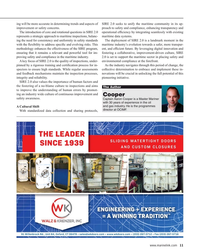 )
April 2024 - Maritime Reporter and Engineering News page: 11
)
April 2024 - Maritime Reporter and Engineering News page: 11is a Master Mariner with 30 years of experience in the oil and gas industry. He is the programmes A Cultural Shift director at OCIMF. With standardized data collection and sharing protocols, THE LEADER SLIDING WATERTIGHT DOORS SINCE 1939 AND CUSTOM CLOSURES ENGINEERING + EXPERIENCE ™ = A WINNING
-
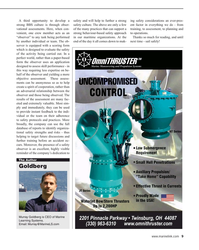 )
April 2024 - Maritime Reporter and Engineering News page: 9
)
April 2024 - Maritime Reporter and Engineering News page: 9A third opportunity to develop a safety and will help to further a strong ing safety considerations an ever-pres- strong BBS culture is through obser- safety culture. The above are only a few ent factor in everything we do - from vational assessments. Here, when con- of the many practices that can
-
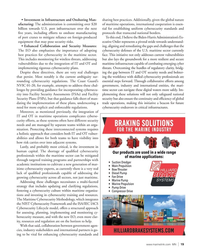 )
April 2024 - Marine News page: 19
)
April 2024 - Marine News page: 19• Investment in Infrastructure and Onshoring Man- sharing best practices. Additionally, given the global nature ufacturing: The administration is committing over $20 of maritime operations, international cooperation is essen- billion towards U.S. port infrastructure over the next tial for establishing
-
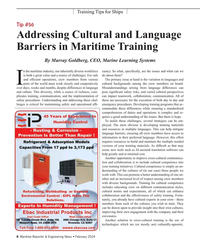 )
February 2024 - Maritime Reporter and Engineering News page: 8
)
February 2024 - Maritime Reporter and Engineering News page: 8for maintaining safety and operational ef? - emergency procedures. Developing training programs that ac- commodate these differences while ensuring a standardized comprehension of duties and operations is complex and re- quires a good understanding of the issues. But there is hope. To tackle these challenges
-
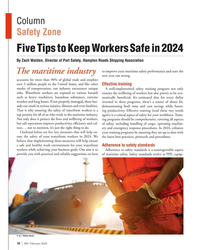 )
February 2024 - Marine News page: 18
)
February 2024 - Marine News page: 18Column Safety Zone Five Tips to Keep Workers Safe in 2024 By Zach Walden, Director of Port Safety, Hampton Roads Shipping Association to improve your maritime safety performance and start the The maritime industry new year out strong. accounts for more than 90% of global trade and employs over 3
-
 )
January 2024 - Maritime Reporter and Engineering News page: 7
)
January 2024 - Maritime Reporter and Engineering News page: 7Training Tips for Ships Tip #55 Maritime Micro-Learning for Mega-Bene? ts By Murray Goldberg, CEO, Marine Learning Systems n our industry as in most others, we typically see on- to be less expensive to update the speci? c microlearning mod- line training content presented as large, comprehensive ules in
-
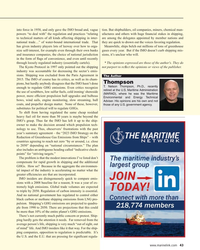 )
December 2023 - Maritime Reporter and Engineering News page: 43
)
December 2023 - Maritime Reporter and Engineering News page: 43into force in 1958, and only gave the IMO broad and, vague tion. But shipbuilders, oil companies, miners, chemical man- powers “to deal with” the regulation and practices “relating ufactures and others with huge ? nancial stakes in shipping, to technical matters of all kinds affecting shipping in inter-
-
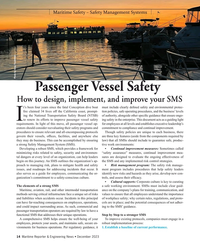 )
December 2023 - Maritime Reporter and Engineering News page: 14
)
December 2023 - Maritime Reporter and Engineering News page: 14Maritime Safety – Safety Management Systems Photo by Greg Trauthwein Passenger Vessel Safety How to design, implement, and improve your SMS t’s been four years since the fatal Conception dive boat must include clearly de? ned safety and environmental protec- ? re claimed 34 lives off the California coast
-
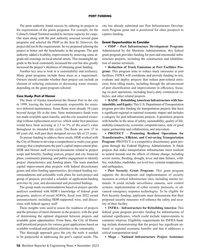 )
November 2023 - Maritime Reporter and Engineering News page: 58
)
November 2023 - Maritime Reporter and Engineering News page: 58PORT FUNDING The ports authority found success by tailoring its projects to city has already submitted one Port Infrastructure Develop- the requirements of the grants programs. For example, for the ment Program grant and is positioned for other prospects to Colonel's Island Terminal needed to increase
-
 )
November 2023 - Maritime Reporter and Engineering News page: 23
)
November 2023 - Maritime Reporter and Engineering News page: 23with wage rises in ? cation societies, ship managers, owners and shipyards - and parts of the supply chain currently exceeding price increases, standardized everything.” such as a shortage of drivers for haulage. www.marinelink.com 23 MR #11 (18-33).indd 23 11/2/2023 9:10:34 A
-
 )
November 2023 - Maritime Reporter and Engineering News page: 22
)
November 2023 - Maritime Reporter and Engineering News page: 22Digitalization Decarbonization Requires Move from Talk to Action More vessels need to be connected to digital systems to realize zero-emissions shipping and data sharing is essential. he Inmarsat Connected Future Conference at this year’s London In- T ternational Shipping Week examined how the industry
-
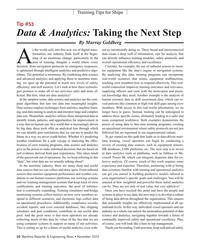 )
November 2023 - Maritime Reporter and Engineering News page: 10
)
November 2023 - Maritime Reporter and Engineering News page: 10Training Tips for Ships Tip #53 Data & Analytics: Taking the Next Step By Murray Goldberg s the world sails into this new era of digital trans- out us intentionally doing so. These broad and interconnected formation, our industry ? nds itself at the begin- data create a deep well of information, ripe for
-
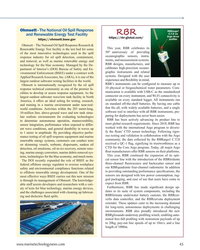 )
September 2023 - Marine Technology Reporter page: 45
)
September 2023 - Marine Technology Reporter page: 4510 physical or biogeochemical water parameters. Com- response technical community as one of the premier fa- munication is available with USB-C as the standardized cilities to develop or assess response equipment. As the connector on every instrument, and Wi-Fi connectivity is largest outdoor saltwater wave/tow
-
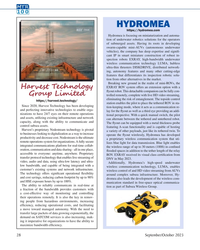 )
September 2023 - Marine Technology Reporter page: 28
)
September 2023 - Marine Technology Reporter page: 28MTR 100 HYDROMEA https://hydromea.com Hydromea is focusing on miniaturization and automa- tion of underwater robotics solutions for the operators of submerged assets. Having its roots in developing swarm-capable mini-AUVs (autonomous underwater vehicles), the company has deep expertise and signi?
-
 )
October 2023 - Marine News page: 25
)
October 2023 - Marine News page: 25the science here, its use, codes and protocols to ensure safety.” Getting the permits In a section referencing “Proposed Future Work,” still for 2023, project managers will seek to ? nalize design and development and pursue permitting “from authorities having jurisdiction.” In the 2023 AMR a section
-
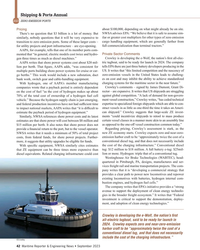 )
September 2023 - Maritime Reporter and Engineering News page: 42
)
September 2023 - Maritime Reporter and Engineering News page: 42vessels in the United States leads to challeng- bank work, switch gear and cable-handling equipment. es on cost and may inhibit the ability to achieve standardized With hydrogen, one of AAPA’s member manufacturing charging systems for the maritime sector in the near future.” companies wrote that a payback
-
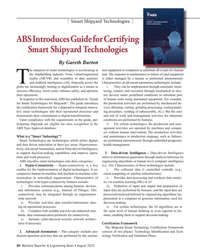 )
August 2023 - Maritime Reporter and Engineering News page: 20
)
August 2023 - Maritime Reporter and Engineering News page: 20Smart Shipyard Technologies ABS Introduces Guide for Certifying Smart Shipyard Technologies By Gareth Burton substituteallorpartofahuman he adoption of smart technologies is accelerating in tion equipment or computers to substitute all or part of a human the shipbuilding industry. From virtual/augmented
-
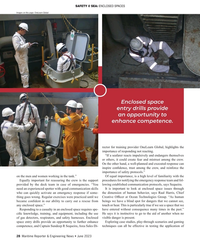 )
June 2023 - Maritime Reporter and Engineering News page: 28
)
June 2023 - Maritime Reporter and Engineering News page: 28SAFETY @ SEA: ENCLOSED SPACES Images on this page: OneLearn Global Enclosed space entry drills provide an opportunity to enhance competence. rector for training provider OneLearn Global, highlights the importance of responding not reacting. “If a seafarer reacts impulsively and endangers themselves
-
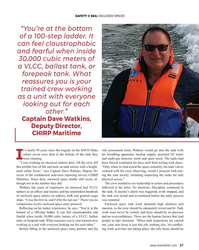 )
June 2023 - Maritime Reporter and Engineering News page: 27
)
June 2023 - Maritime Reporter and Engineering News page: 27SAFETY @ SEA: ENCLOSED SPACES “You’re at the bottom of a 100-step ladder. It can feel claustrophobic and fearful when inside 30,000 cubic meters of a VLCC, ballast tank, or forepeak tank. What reassures you is your trained crew working as a unit with everyone looking out for each other.” Captain
-
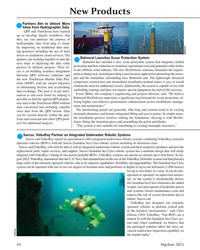 )
May 2023 - Marine Technology Reporter page: 44
)
May 2023 - Marine Technology Reporter page: 44of one-person portable ROVs. VideoRay systems can operate in currents up to four knots. In Au- gust 2022, VideoRay announced that the U.S. Navy had standardized on the use of the VideoRay Defender system and had placed a large order of the remotely operated vehicles, due to its superior capabilities, ?
-
 )
May 2023 - Marine Technology Reporter page: 42
)
May 2023 - Marine Technology Reporter page: 42CABLING PIONEER CONSULTING ing and permanent reservoirs monitoring. Fiber optic cables branching units with OADM technology to deliver 200 Gb/s also help to create a safer operating environment with a more of bi-directional communications to each cable landing stations connected workforce and more ?
-
 )
May 2023 - Maritime Reporter and Engineering News page: 56
)
May 2023 - Maritime Reporter and Engineering News page: 56TECH FEATURE SHAFT GENERATORS & THE SWITCH All images courtesy Yaskawa Environmental Energy / The Switch SHAFT GENERATORS 101 – WHAT ARE THEY? Yaskawa Environmental Energy / The Switch shines a light on how to produce electricity ef? ciently on ships. ship is like a ? oating city that needs electricity
-
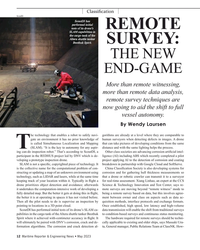 )
May 2023 - Maritime Reporter and Engineering News page: 12
)
May 2023 - Maritime Reporter and Engineering News page: 12Classi? cation ScoutDI ScoutDI has performed initial REMOTE tests of its drone’s SLAM capabilities in the cargo tank of the Altera shuttle tanker Beothuk Spirit. SURVEY: THE NEW END-GAME More than remote witnessing, more than remote data analysis, remote survey techniques are now going to aid
-
 )
April 2023 - Marine News page: 29
)
April 2023 - Marine News page: 29tial dangers for crew members. When asked about these concerns, Woo noted that the company is working with the U.S. Coast Guard and partnering with classi? cation society DNV to ensure alignment with all maritime safety standards. Amogy’s solution also has approval in principle (AIP) from classi?
